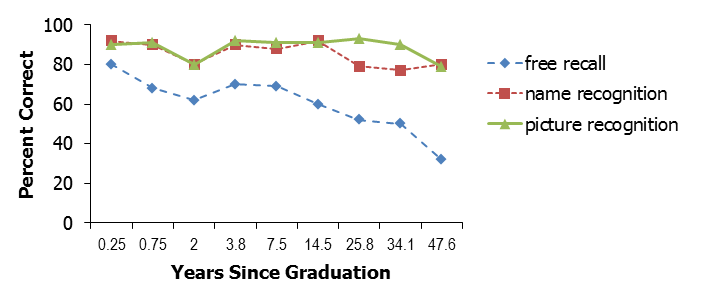
1. Describe the structure of autobiographical memory.
2. What are infantile amnesia and permastore?
3. What are three kinds of distinctiveness that can affect memories? What are flashbulb memories?
4. How does Elizabeth Loftus use false memories to show the constructive nature of memory?
5. How does the source monitoring framework explain memory errors?
6. What is misinformation, why do people believe it, and what can be done about it?
• a form of long-term memory that comprises the self-knowledge, episodes, and experiences of a person’s life
• is crucial to our self-conception, helping us to understand who we are and how we relate to the world
• utilizes the two primary types of declarative memory:
- ________ semantic memories: facts and ideas about ourselves
- episodic memory: memory of events we have experienced
• organized by tiers of specificity (Conway & Pleydell-Pearce, 2000):
- lifetime periods: distinguishable time periods in one’s life
e.g., “When I was in university...”
- general events: represent repeated events or a sequence of related events
e.g., “...I was a member of the debate club...”
- event-specific knowledge: details about a single event
e.g., “...and I won the annual debate championship.”
- this knowledge is used by the working self: current personal goals and self-images
e.g., “This experience makes me an excellent candidate for this job.”
• _________ (or infantile) amnesia: adults’ inability to remember events before ages 3-5
- average age of earliest memory is ˜3.5 years of age
- females report earlier memories than males
- recall of memories over the lifespan falls off before age 8 compared to other periods
- Freud (1916): “the remarkable amnesia of childhood” is due to repression of traumatic experiences of early psychosexual development
- contemporary theories:
▸ ___________ (involved in storage of long-term memories) not sufficiently mature before age 2
▸ incomplete language development is a barrier to encoding autobiographical memories (which include episodic and semantic components)
▸ episodic memories are tied to one’s sense of ____, which develops later in life
• Bahrick, Bahrick, & Wittinger (1975):
- studied retention of names and faces of people’s high school classmates (vs. strangers)

- __________: very long-term storage that can last your entire life
Distinctiveness can help to make the relationship between cue and item unique
Unique item activates fewer memories in LTS and reduces ____________
• _______ distinctiveness: incongruity defined with respect to the immediate context
Rabinowitz & Andrews (1973):
- _________ effect (von Restorff effect, 1933): a distinctive stimulus is more likely to be remembered
- control list: words printed in black capital letters
- isolated list: one item printed in red capital letters
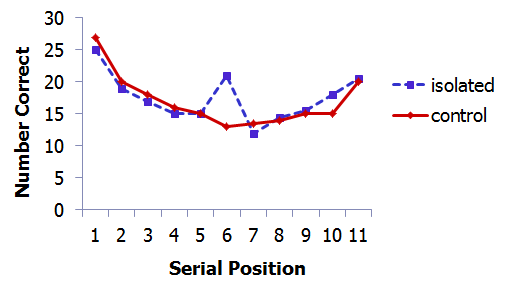
• _________ distinctiveness: incongruity is defined with respect to past experience
e.g., first day of university, first time in a big city
Hunt & Elliott (1980):
- ____________ distinctiveness: word having unusual letter and spelling patterns
- better remembered than more typical words
e.g., llama, khaki, afghan (vs. leaky, kennel, airway)
- due to unusual lower-case word _____ (no effect when in CAPITALS)
• _________ distinctiveness: emotional events are remembered in greater detail
_________ memories: detailed, vivid recollection of circumstances surrounding hearing about a surprising/emotional event
Brown & Kulik (1977):
- asked people about their personal circumstances when they heard about the assassination of John F. Kennedy
- people gave many details, and were confident in their memories
- this effect is linked to the release of adrenaline, causing greater amygdala activity (McGaugh, 2004; 2013)
- seems intuitive; much _________ evidence
- problem: were the reported memories accurate?
Solution is ________ recall: record person’s memories and experiences immediately following an emotional event and compare to later surprise reassessment.
Bohannon (1988)/Bohannon & Schmidt (1989):
- tested students’ memory for events surrounding explosion of space shuttle Challenger
- 3 groups: tested 2 weeks, 8 months, or 15 months later
- measure of _______:
How upset were you (1-7)?
- shuttle _____:
How many were on board?
How long into the flight did it explode?
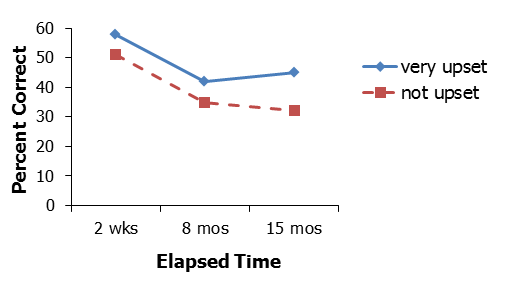
- personal _________:
Where were you when you heard of the explosion?
What were you doing?
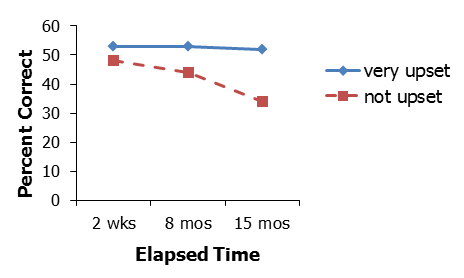
- emotion appeared to _______ memory, but memory was not perfect
• ______ illusions: mismatches between percept and objective stimulus
- sensory data available
- persist even when we know our interpretation is incorrect
• ______ illusions: erroneous judgments based on memories
- sensory data no longer available
- difficult to become aware of; we often cannot compare our memory to the actual event
Roediger & McDermott (1995, based on Deese, 1959):
- participants studied 15-word list
e.g., water, stream, lake, Mississippi, boat, tide, swim, flow, run, barge, creek, brook, fish, bridge, winding
- recall of studied words: 65%
- recall of strongly semantically related critical lure (_____): 40%
- confidence measured in recognition task (4-point scale)
- results:
studied items |
unrelated lure |
critical lure (river) |
|
confidence: |
3.6 |
1.2 |
3.3 |
- shows memory is associative
Freud (1901):
- __________: active submerging of a painful memory without conscious awareness
- considered this to be the most powerful defence mechanism used by the ego to reduce anxiety
- not confirmed experimentally
_____ ______ syndrome: memory of traumatic experience which is objectively false, but in which the person strongly believes it to be true
- “recovered” memories may be false memories, based on events that never occurred. How?
- FMS can be elicited by “recovered memory therapy,” in which a therapist encourages a client to identify repressed memories (e.g., of abuse), despite the lack of evidence or memory of any past abuse
- psychotherapists ask _______ questions that may elicit compliance with generation of false memory
- this approach (often using hypnosis) can cause false memories to be _________
e.g., one woman believed she had endured ritualistic abuse, was forced into a pregnancy, and the baby was cut from her uterus--but there were no physical scars or any other physical evidence
- led to the “memory wars” debate over the existence of repressed memories of abuse
Loftus & Pickrell (1995):
- can people be made to (incorrectly) remember that they were lost in a mall in childhood?
- experimenter interviewed relatives of participants
- participants were given paragraphs describing four events from their childhood (three true events and one _____--but plausible--event)
e.g., false story about being lost at a mall at age 5
- participants wrote what they remembered about each event immediately after, and in two follow-up interviews
- results:
• 68% of true events remembered
• 29% of participants “remembered” false events
• more words were used to describe the true events, and they were also rated as being somewhat more clear than the false events
Other implanted false memories:
• accidentally spilling a bowl of punch on the parents of the bride at a wedding reception when they were 5 (integrating false event into actual events provided by parents of participants) (25% of people; Hyman & Billings, 1998)
• being a victim of a vicious animal attack in childhood, facilitated by an interviewer using “guided imagery” (26%; Porter et al., 1999)
• believing they committed a crime (theft, assault, or assault with a weapon) that led to police contact (70%; Shaw & Porter, 2015)
• going on a hot-air balloon ride after seeing a Photoshopped photo (50%; Wade et al., 2002)
• meeting ____ _____ at Disneyland after seeing a fake print ad (16%; Braun et al., 2002)
• liking asparagus as a child (Laney et al., 2008)
Elizabeth Loftus (b.1944): won the Grawemeyer Award in Psychology in 2005
• in 80,000 cases/year in USA, the only critical evidence is eyewitness identification
• 2,000-10,000 estimated wrongful convictions/year due to ______ eyewitness testimony
The Innocence Project has helped exonerate over 200 wrongful convictions through DNA testing since 1989 (The Innocence Project, 2024)
• 63% involved eyewitness misidentification
• Innocence Canada has helped exonerate 29 people (Innocence Canada, 2024)
Loftus & Palmer (1974):
Expt. 1: participants saw film of a collision
- were asked, “How fast were the cars going when they _______?”
- word affected speed estimates:
Descriptive word |
Speed estimates |
“smashed” |
40.8 mph |
“collided” |
39.3 mph |
“bumped” |
38.1 mph |
“hit” |
34.0 mph |
“contacted” |
31.8 mph |
- could participants judge the speed properly?
• film of car crash at __ mph estimated to be 37.7 mph
• __ mph estimated to be 36.2 mph
• two films crash at __ mph estimated to be 39.7 and 36.1 mph
Expt. 2: participants saw film of a multiple-car crash
- were asked about ______ _____
• “smashed” = 32% yes
• “hit” = 14% yes
______________ effect: exposure to misleading information after witnessing an event can lead people to believe that they have seen or experienced something they never did; possible causes:
• overwriting: misleading information ________ memory trace of the actual experience
• misinformation acceptance: people believe the post-event information is true because questioner is a person of _________
• ______ confusion: memory of the question is confused with memory of the experience
Source Monitoring Framework
• _______ monitoring: “processes by which people discriminate between memories derived from perception and those that were reflectively generated via thought, imagination, dreams, and fantasy” (Marcia Johnson, 1991)
• ______ monitoring: process of making attributions about the source of memories
- memories are not “tagged” with source information
- attribution occurs during retrieval; may be incorrect
• source monitoring errors:
- source _________ (or source misattribution): believing the source of a memory is different than what it actually is
- source _______: not remembering the source of a memory
- ____________ (“hidden memory”): remembering a previously forgotten memory, but believing it to be new and original
e.g., George Harrison’s “My Sweet Lord” (1970) (inadvertently?) plagiarised the Chiffons’ “He’s So Fine” (1962)
Lindsay & Johnson (1989):
- showed picture of office, then read text describing the office
- some text was misleading (described typical things in an office which were absent)
e.g., “... a filing cabinet behind the woman...”
- recognition test: was item in the picture?
• showed evidence of suggestibility
- source-monitoring test: was item in picture, text, or both?
• much fewer errors; suggestibility effect gone
- conclusion: source monitoring occurs at _________
Affected by:
• __________ information
e.g., where were you when you last had your wallet?
• _______ information
e.g., do you remember the feel of your wallet when you put it into your pocket?
• fewer cognitive __________ (i.e., memory retrieved with little effort)
e.g., remembering where you put your wallet
Although memory may be _________, eyewitness testimony may be reliable under proper conditions (Wixted et al., 2018):
• an initial memory test is least likely to be contaminated (subsequent tests are more likely to be contaminated)
• police lineups should be ____ (e.g., suspect does not stand out)
• eyewitness’ __________ should be recorded (it is correlated with accuracy)
What is it?
• misinformation: misleading or incorrect information
• ______________: intentionally misleading or incorrect information
Why is it a problem?
• WHO declared a “massive infodemic” of misinformation about COVID-19 in March, 2020
• this included false claims that:
![]() you could do a self-test for the SARS-CoV2 virus by holding your breath
you could do a self-test for the SARS-CoV2 virus by holding your breath
![]() drinking large amounts of water protects against the virus
drinking large amounts of water protects against the virus
![]() gargling salt water prevents infection
gargling salt water prevents infection
• social media played a large role in this, with millions of posts of COVID-19 misinformation on online platforms including Twitter, Instagram, and YouTube (Cinelli et al., 2020)
• this has led to harm: misinformation has been blamed for vaccine hesitancy and a decrease in life expectancy in the USA of 3-5 years
Why do people believe misinformation?
• when experiencing emotional motivators, including heightened fear or anger
e.g., during a global pandemic
• if they are frequent users of social media, less educated, and on the political extremes
• motivated reasoning: tendency to accept information based on its desirability, rather than its accuracy, because of your emotions, values, and preferences
e.g., a fan believes their favorite team will win despite poor performance because they emotionally need that optimism
• confirmation bias: tendency to seek evidence that confirms one’s existing beliefs (and disregard contrary information)
e.g., a fan reads only articles and stats that support their teamís chances of winning
• ________ _____ effect: repeated exposure to misinformation may make people more likely to believe it (partly due to processing fluency: when information is repeated, it becomes more familiar and easier to process)
e.g., seeing false postings about a miracle cure on social media can increase belief in it
How can misinformation be combated?
• _________: correcting the effects of misinformation post-exposure; like fact-checking (Lewandowsky et al., 2022)
- truth sandwich technique:
1. Fact: give the truth first
2. Warn about the myth: describe the misinformation
3. Explain fallacy: explain why the misinformation is wrong
4. Fact: repeat the truth again, with credible alternative explanation
• __________: developing immunity to misinformation in the future by using psychological inoculation techniques
- based on inoculation theory (McGuire, 1961), which uses the metaphor of protection against disease by immunization
- pre-exposure to weakened versions of a stronger, future threat can safeguard an attitude or belief from influence or persuasion
- includes a forewarning about harmful misinformation, and pre-emptive disproof of the falsehood
- prebunking found to be more effective than debunking (Jolley & Douglas, 2017)
• evidence (van der Linden et al., 2017):
- asked people’s beliefs about topics including climate change
- dependent variable: 0-100 agreement whether humans are causing global warming
- over 2,000 participants then randomized into independent variable conditions:
▸ facts-only group: told there was 97% consensus among climate scientists about human-caused climate change
▸ misinformation only: shown “Global Warming Petition Project”
▸ _____-_______: got facts and misinformation
▸ inoculation: given forewarning about misinformation, and facts
▸ full inoculation: received forewarning, facts, and prebunk about the bogus petition
- latter two groups were then exposed to the misinformation
- results: change in dependent variable pre- vs. post
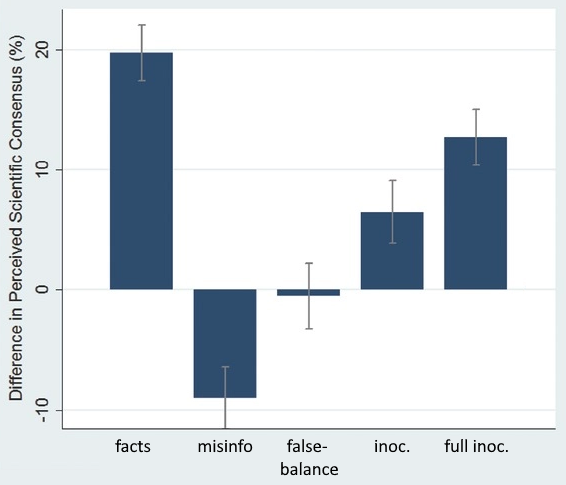
- conclusion: psychological inoculation (prebunking) is effective against misinformation
How can this research be applied?
• _________ other people (Garcia & Shane, 2021):
- fact-based: correcting a specific false claim by communicating accurate information
e.g., explaining that it is not possible to get the flu from the flu vaccines because most of them contain inactivated strains of the virus
- logic-based: explaining misleading tactics used to manipulate people, and refuting logical fallacies
e.g., pointing out inherently contradictory claims like “global temperatures cannot be accurately measured” and “temperature records show the climate has been cooling”
- source-based: undermining the credibility of bad sources of information
e.g., ridiculing people who believe that reptilian “lizard people” are controlling the world reduced others’ beliefs in it
• YouTube video campaign by Truth Labs for Education
• online games: Bad News (about “fake news”), Harmony Square (about political disinformation), and Go Viral! (about COVID-19 misinformation)
The “infodemic” of misinformation thrives on our emotions and biases, but we can fight back by learning to prebunk false claims and inoculate ourselves using an understanding of cognitive processes.